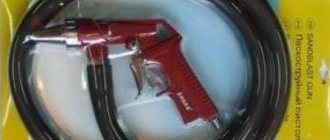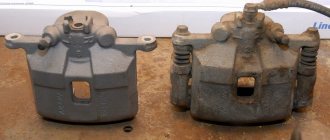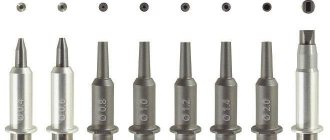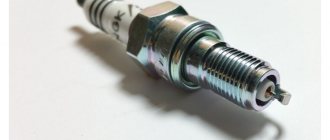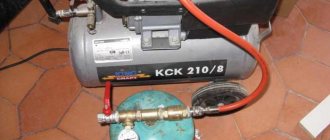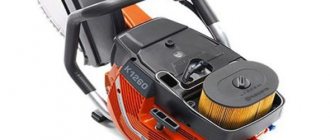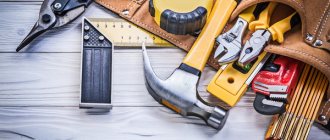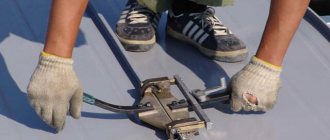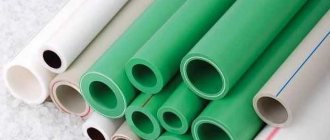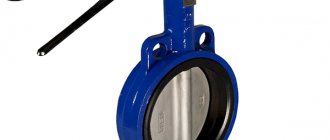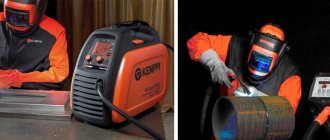The compressor used to equip the sandblasting machine is the most important element, the correct choice of which largely determines the efficiency of the entire system. The technical characteristics of this device also have a direct impact on the performance of the processing performed and on such an important parameter as the consumption of abrasive material.
A sandblasting unit and a compressor are two essential components of one metalworking system
Compressor selection
The sandblasting compressor is the most expensive device among all the elements of the system used to perform such a task. When equipping a device for sandblasting, many, guided by a natural desire to save money, purchase the cheapest compressors, the technical characteristics of which do not meet the required parameters.
The use of a compressor, the technical parameters of which do not correspond to the characteristics of the sandblasting machine used, leads to the fact that the speed of processing is significantly reduced, the consumption of abrasive material per unit of surface area processed increases, as a result, the deadlines for completing the work are missed and their cost increases.
That is why specialists, when choosing a compressor for sandblasting, evaluate not only the volume of work to be carried out, but also the deadlines that must be met. To select a compressor, special tables are most often used, which show the ratios of such parameters as:
- the pressure that the compressor is capable of providing;
- level of compressed air consumption by a sandblasting machine;
- consumption of abrasive material per unit area of the surface being treated;
- speed of processing.
Abrasive, air consumption and productivity
The data on the consumption of abrasive material, which are indicated in such tables, are indicative for the reason that the value of this parameter is influenced by many factors. Such factors, in particular, are: the type of surface being treated, the nature and thickness of the layer of dirt or old coating being cleaned, the height to which it is necessary to raise the abrasive mixture, the experience and qualifications of the work performer. Despite the not very high accuracy of this parameter given in the tables, they give an idea of which compressor to choose.
Important parameters
If we evaluate the importance of two main characteristics of any compressor: performance, measured in the volume of air supplied per unit of time, and the pressure under which such air is supplied to the sandblaster nozzle, then we can conclude that they are both important.
If we talk about compressor performance, which can be measured in units such as liter/min and m3/min, then it should be noted that this parameter affects the speed of processing and the quality of the working mixture consisting of abrasive material and air. Compressor equipment, characterized by high performance, makes it possible to use nozzles with holes of larger diameter, thereby increasing the diameter of the treatment spot and, accordingly, the speed of its implementation. Most models of modern sandblasting machines operating on the pressure principle require compressors capable of providing productivity in the range of 2.2–17 m3/min.
Compressor performance calculation
The choice of a compressor based on the pressure it can provide depends primarily on the characteristics of the surface being treated. Thus, to perform effective sandblasting of structures made of concrete, brick and natural stone, you need a compressor that can provide a pressure of about 3-5 bar, and for high-quality cleaning of metal surfaces - 5-8 bar. Higher pressure (about 9–12 bar) is required in cases where it is necessary to remove a thick layer of old coating or material that is highly abrasive from the surface being treated. A compressor capable of providing such pressure will also be required if the abrasive mixture needs to be supplied over a significant distance: over 60 meters.
When a sandblasting machine operates, the main part of the pressure is lost not in the hose supplying compressed air from the compressor, but in the hose through which abrasive material is supplied from the container. That is why, if it is necessary to perform sandblasting work at a considerable distance from the compressor unit, this distance must be covered by the length of the air hose, and the hose for supplying the abrasive material should be kept to a minimum length.
Scope of sandblasting machines
You should start with the area where sandblasting is used. The most famous application of this processing method is for cleaning metal during body repair or when painting car rims. Devices for such processing have high pressure, with the help of which a sand jet removes the remains of old paint, soil, rust or scale from the metal surface.
Sandblasted metal lasts much longer after painting, largely due to the fact that such cleaning is better than other methods of removing metal coating. Small grains of sand cut into the surface being treated at high speed, thereby knocking down even those traces of corrosion that are located in small pores or cracks, where they are difficult to reach with traditional tools.
In addition to the quality of cleaning from old coating and traces of corrosion, sandblasting leaves behind a smoother surface. There are no scratches that occur after using brush cleaning, or using sandpaper with large abrasive particles. This makes it much easier to apply the first layer of primer and improves the quality of its adhesion to the metal.
In addition to body repair, sandblasting is widely used in other areas of human activity. This is how large ships, parts and products are cleaned in factories. In addition to metal, this processing method is also applicable to other types of materials, for example, for cleaning wood, brick or concrete products.
Sandblasting machines are used to create specific effects on wood or glass. Wooden products after processing can acquire all kinds of patterns. Sandblasting is used to frost glass, which is used for decorative purposes, for example, for engraving in the form of different patterns. Some sandblasting machines can be used to drill holes in glass, which can be round or other shapes.
Screw or piston compressor unit?
Piston compressors, which supply compressed air to the system with significant surges, are rarely used to complete sandblasting machines. Due to such jumps, the abrasive material mixes unevenly with the air flow, forming numerous lumps that not only reduce the pressure of the abrasive jet, but also clog the nozzle of the device. You can eliminate pulsations of air pressure in the system when using a piston compressor if you include a receiver in the system and select a compressor unit that can provide greater pressure than is required for the operation of a sandblasting machine. Another disadvantage of such compressors, which in case of urgent need can be used to perform short-term sandblasting work, is that they are characterized by a significant removal of compressor oil.
When choosing a compressor, consider the average service life, depending on the type of equipment
Screw-type compressor units, mainly used to complete sandblasting machines, do not have all such disadvantages. Such installations, which are economical to use and maintain, are capable of providing the sandblasting machine with compressed air for a long period of time, the pressure level of which remains stable.
Neutralization of oil
If oil gets into the base, it can cause a variety of unpleasant consequences. To remove oil, a special trap is installed.
The unit in question is usually installed at the outlet of the sandblasting compressor. Due to this, the efficiency of this installation is significantly increased.
Diesel or electric compressor?
Sandblasting machines today can be equipped with compressor units driven by electric or diesel engines. Which of these compressors to choose depends on a number of factors. It is clear that it will not be possible to use an electric compressor if there is no possibility of connecting to the electrical network. Meanwhile, autonomy and mobility are not the only advantages of diesel compressors.
A modern diesel compressor is a powerful unit equipped with various systems that ensure efficient operation with any tool.
Most modern models of such devices are equipped with an effective system for adjusting their performance, which works on the following principle: at the moment when the consumption of compressed air by the sandblasting machine decreases, such a system automatically reduces the speed of the installation’s drive engine; Accordingly, when compressed air consumption increases, engine speed also increases. Similar systems can also be installed on electric compressors, but due to the design features of such devices they are much more expensive.
The advantages of electric compressors include the simplicity of their design; they are more economical to operate and maintain. Among such compressors on the modern market there are both stationary and mobile models, transported using a special chassis with which they are equipped. A limitation for the use of electrical installations is also that for the sandblaster to operate effectively, a compressor is required, the engine of which has a power in the range of 22–100 kW. Not every electrical network can withstand connecting such a motor.
Compressors operating from a 220-volt network are practically never equipped with motors more powerful than 3 kW
If you choose which compressor to purchase, taking into account the economic component of its use, the choice of electrical devices will be more preferable.
Room for working with a sandblasting machine
When working with a sandblasting machine, it is a good idea to take care of creating the necessary conditions in the workroom. The main enemy of sandblasting is excess moisture, since when sandblasting is carried out, productivity can be significantly affected by its humidity. Therefore, first of all, care is taken to remove excess moisture from the room. Also for this purpose, professional sandblasting machines are equipped with air dryers, which is taken and supplied from the compressor to the working gun.
An equally important factor is the purity of the air from impurities. In addition to cleaning it in the workroom, filtration is used directly in the devices. The suction flow is cleared of oil and other impurities, which ensures better mixing with sand and supply to the working area.
Also, the sandblasting chamber should be able to be easily cleaned of sand residues. If you work with sandblasting at an amateur level, then you should choose a room for this where the sand will not interfere. After all, it will be very difficult to completely remove it. It is best to equip a special sealed chamber for this work and use it only for these purposes.
Recommendations for operating compressors in winter conditions
Those who are going to use a compressor as part of a sandblasting system should definitely know how to avoid the formation and concentration of moisture-oil condensate in the lines, which not only reduces the performance of the device, but can also lead to its complete stop. The presence of such condensate in the supply lines leads to the wetting of the abrasive material, its sticking and the formation of lumps, and if metal shot is used as such material, then the condensate contributes to its corrosion and, as a result, to a decrease in its quality characteristics. Compressor oil, which is also present in the condensate, if it gets on the surface being treated, negatively affects the quality of the cleaning performed.
When operating the compressor in winter, replace the “summer” oil with oil with a pour point of at least 25 degrees
In order to remove already formed condensate from the system, special moisture-oil separators are used, operating on the principle of a cyclone separator, but they are unable to stop the process of its formation. To solve this problem, various devices can be used in sandblasting systems, the most common of which include:
- compressed air coolers;
- coalescent filters;
- refrigerated dryers.
You can make a moisture separator yourself, for example, from an oil filter from a Volgov engine
When operating compressor units at low temperatures (from minus 5 degrees), they must be additionally equipped with pre-heaters and “cold start” systems. Naturally, the oil used in compressors in such cases must also be designed for winter operation.
How to choose the right model?
When choosing, pay attention to the following design elements of the pistol:
- A set of nozzles and the material from which they are made. Sandblasting nozzles made from a hard alloy based on cobalt and tungsten carbide clearly have an advantage in terms of durability.
- Method of attaching the nozzle to the body: the union nut can spontaneously unscrew during long-term operation, especially with vibrations, while the threaded pin is more reliable.
- Ergonomic handle and convenient location of shut-off and control valves.
- The presence of mounting holes on the gun body: this allows, having secured the device, to move the part to be cleaned with your hands relative to it.
Naturally, the performance characteristics of the purchased sandblasting gun must be consistent with the capabilities of the compressor. In particular, when constantly cleaning complex surfaces, the pressure of the abrasive-air mixture for which the device is designed should be as high as possible. It is recommended that the compressor have a pressure reserve of at least 15...20%.
Much in the choice depends on the nature of the surfaces that will have to be cleaned. For example, for brick, concrete or other building materials, the adhesion forces of contaminants are not as great as for metals, but the uniformity of spraying is very important, and the power of the jet may be less. Here, ejector-type sandblasting devices have a clear advantage.
Their most popular models are worth noting:
- Sandblasting guns SGI and Gi - the manufacturer always equips them with carbide nozzles of its own production, which is convenient and does not create problems with interchangeability. The price of SGI pistols is from 3,500 rubles. ;
- Guns from GI-Auto, which can be permanently fixed on any surface that has at least two holes. Price - from 5000 rubles;
- Pistols from the Aquarita line, which are distinguished by a completely budget price - from only 1300 rubles.
Used compressor equipment
When deciding what compressor equipment to buy in order to spend less money, many decide to buy a unit that has already been used. Acting in this way, you should take a very responsible approach to choosing equipment so as not to end up in a situation where you have to constantly repair your compressor installation. It should also be borne in mind that a compressor that has already been operating for some time is not capable of providing the characteristics specified in the data sheet for new equipment. This state of affairs is due to the fact that any equipment used is subject to natural wear and tear, which certainly does not affect its efficiency in the best way.
The advantage of buying a used compressor is the ability to purchase a more powerful unit for little money.
Used compressors, in addition, are characterized by increased fuel consumption, which leads to an increase in the cost of sandblasting work. One should not discount the fact that such equipment may fail at any time, which will lead not only to additional costs for its repair, but also to delays in completing work, and this is very critical in many situations. The average normal life of compressor equipment is 7–10 years, so purchasing a compressor that has already worked for such a period of time is simply not practical.
Two words about veterans
The last and perhaps most important (in our realities) question is whether to buy a new or used . When buying a compressor for a sandblasting machine from your own hands, you should be prepared for several rather unpleasant nuances:
- general wear and tear of the unit;
- lubricant consumption;
- reduction in passport pressure and productivity;
- increased noise and vibration levels;
- total time between failures.
All these factors may unpleasantly surprise you.
It is clear that the service life of the compressor will significantly affect its performance parameters, which may differ greatly from the declared factory ones. This, in turn, will greatly change the cost of operation, in particular the need for maintenance and lubricant replacement .
In the case of operating diesel compressors, everything is even more complicated. We are talking about a sharp increase in fuel and lubricant consumption, which will ultimately lead to an increase in the cost of work performed. It is believed that the cost of operating diesel compressors increases sharply after three years of active operation.
Homemade compressors
For those who like to do something with their own hands and want to save a lot on purchasing a commercial compressor, there is a good option: make a homemade device that will allow you to effectively perform simple sandblasting at home.
Compressor circuit
As the main element of a homemade device for producing compressed air, which will determine its technical characteristics, you can use ready-made compressors from the pneumatic brake drive of old MAZ and ZIL cars (130–157). Such compressors are also available in equipment from the MTZ and GAZ brands, but they are low-performance, and the devices from KAMAZ vehicles require significant modification. As a receiver that will need to be installed on such a device, you can use a regular gas cylinder with a capacity of 50 liters. An electric motor of both 220 and 380 V is suitable to drive the compressor head.
With your own hands, for such a homemade compressor, you only need to make a frame on which all the component elements of the device are assembled into a single structure.
More on the topic: > Do-it-yourself sandblasting: drawings, videos, manufacturing instructions > Sandblasting nozzle: rules for choosing and making it yourself > Sandblasting from Karcher: nozzle for a high-pressure washer
